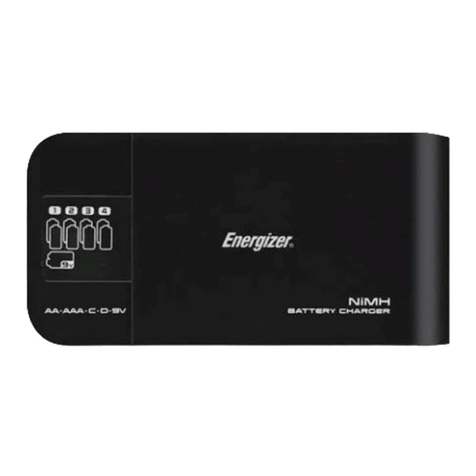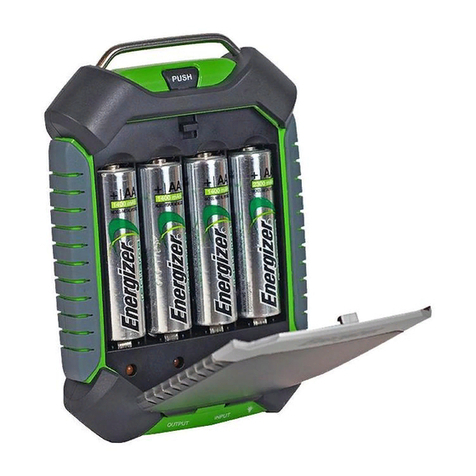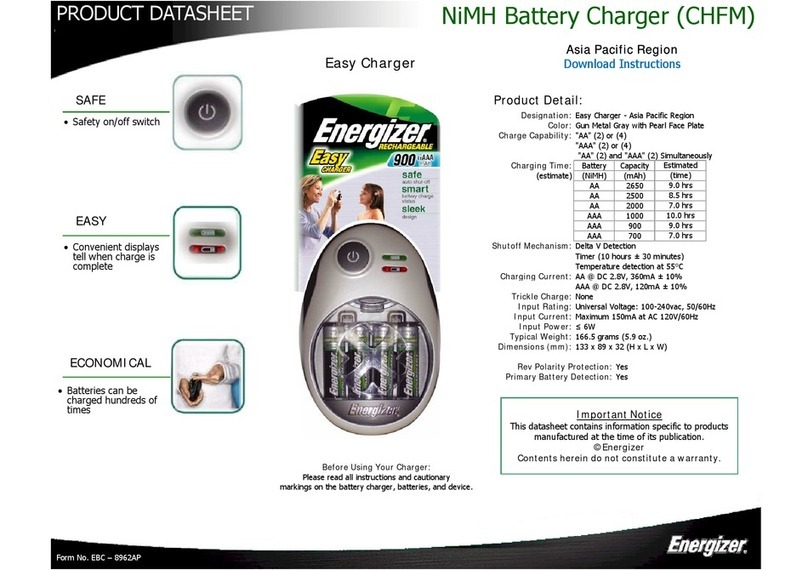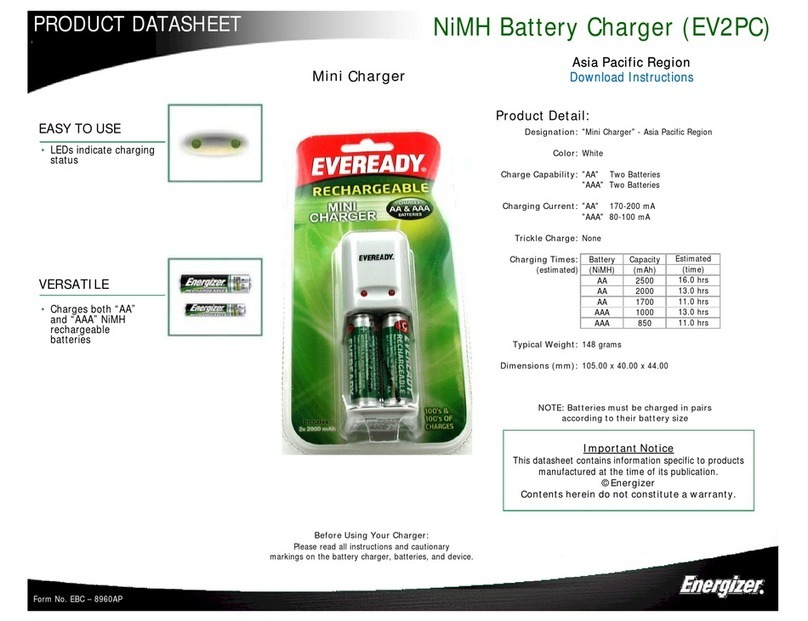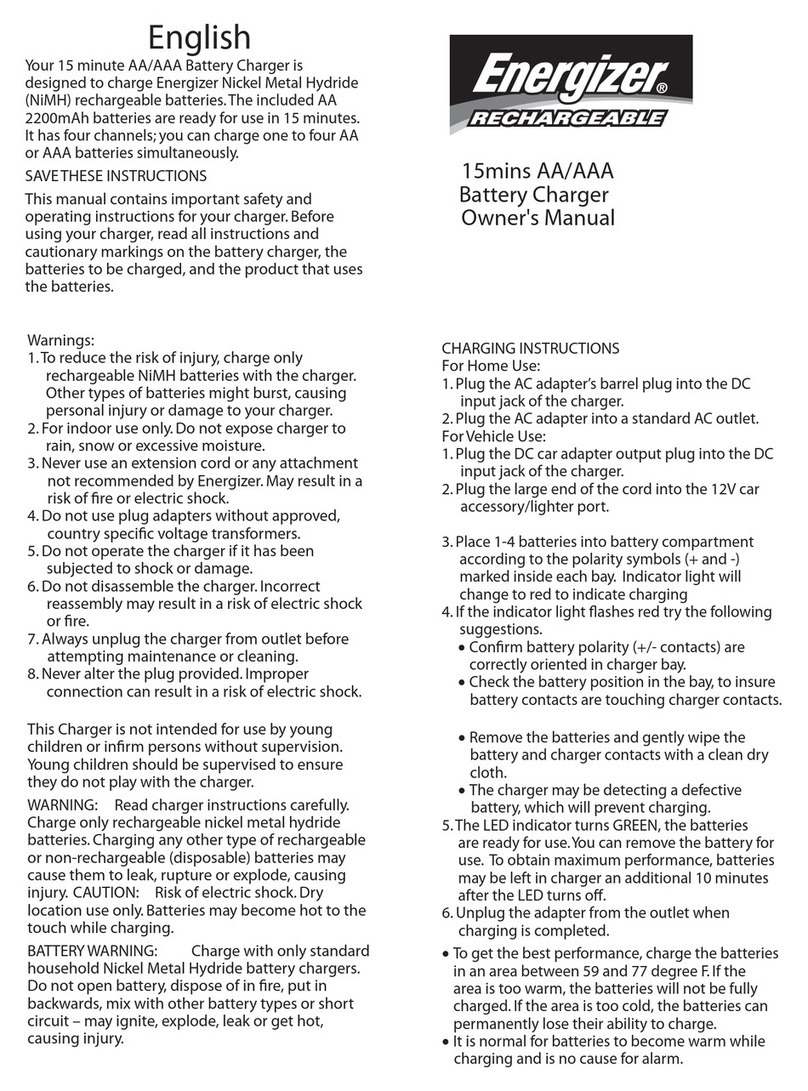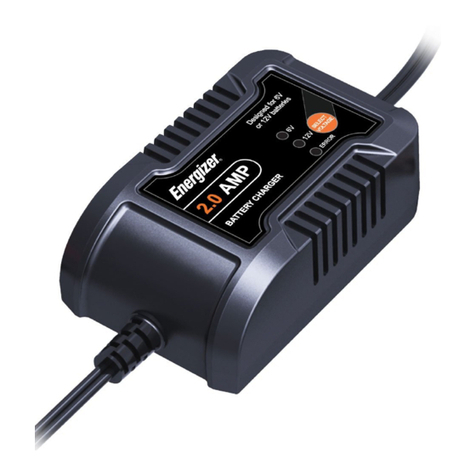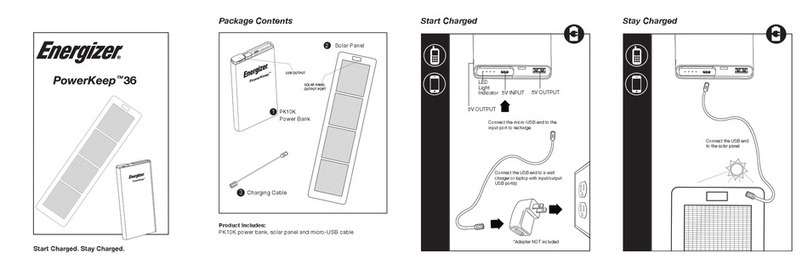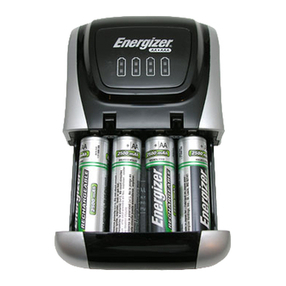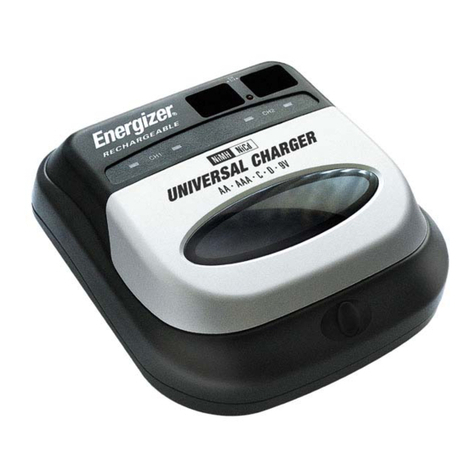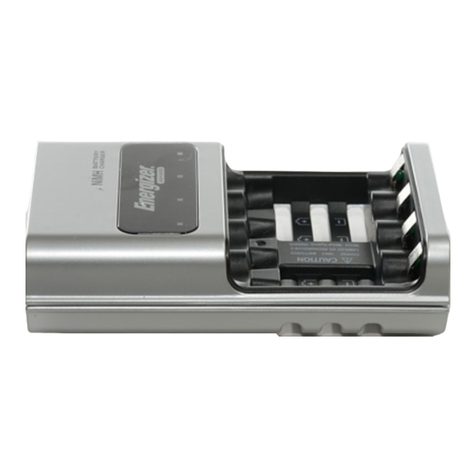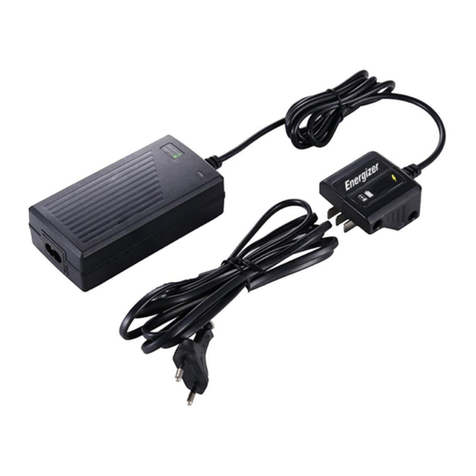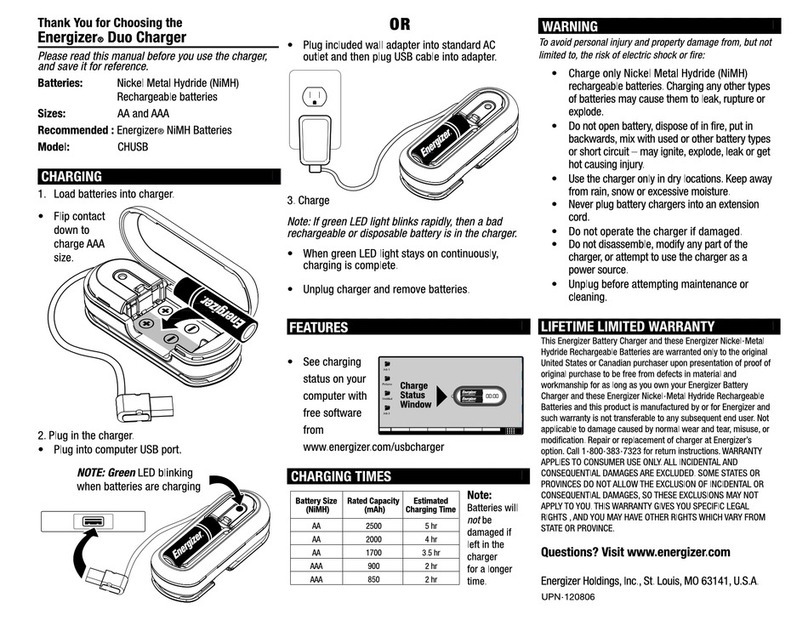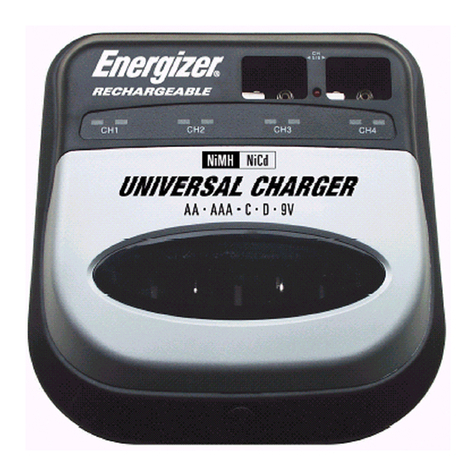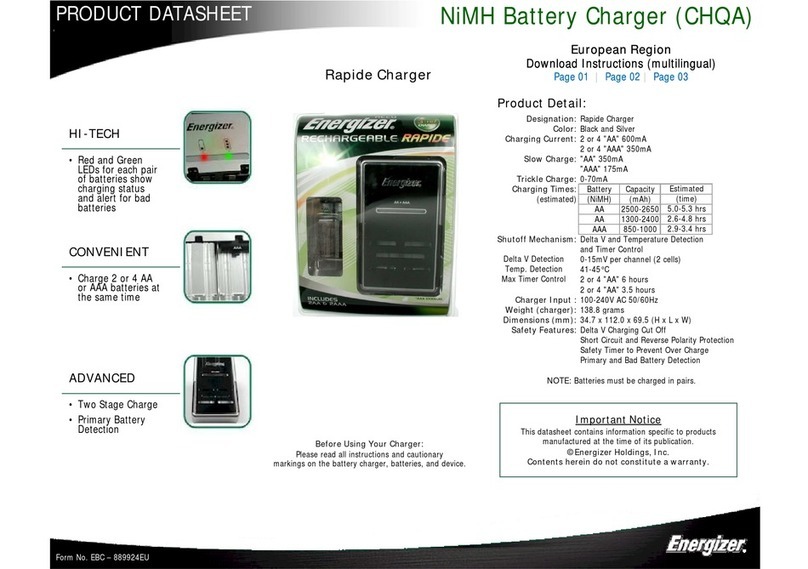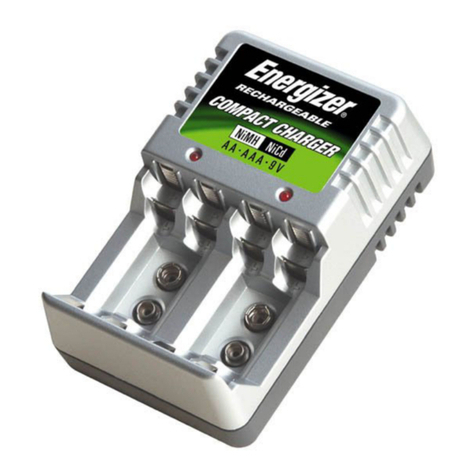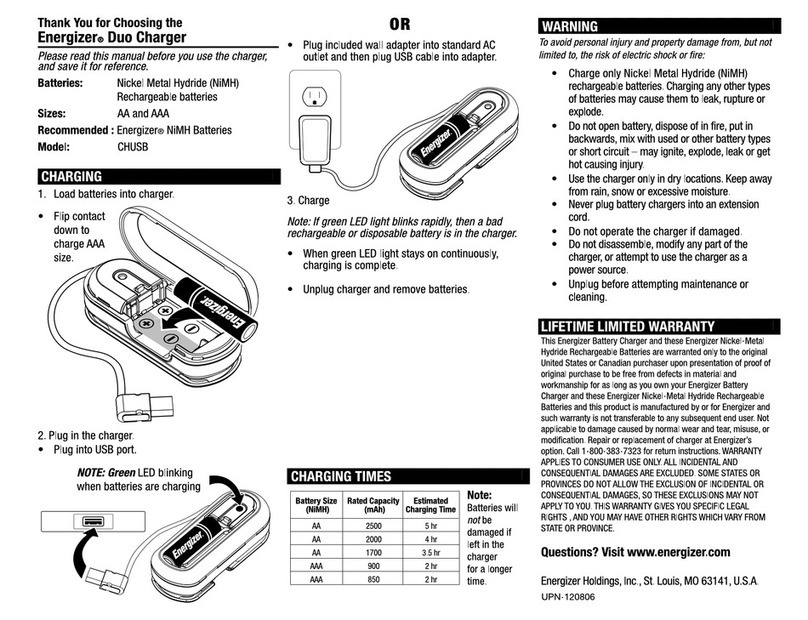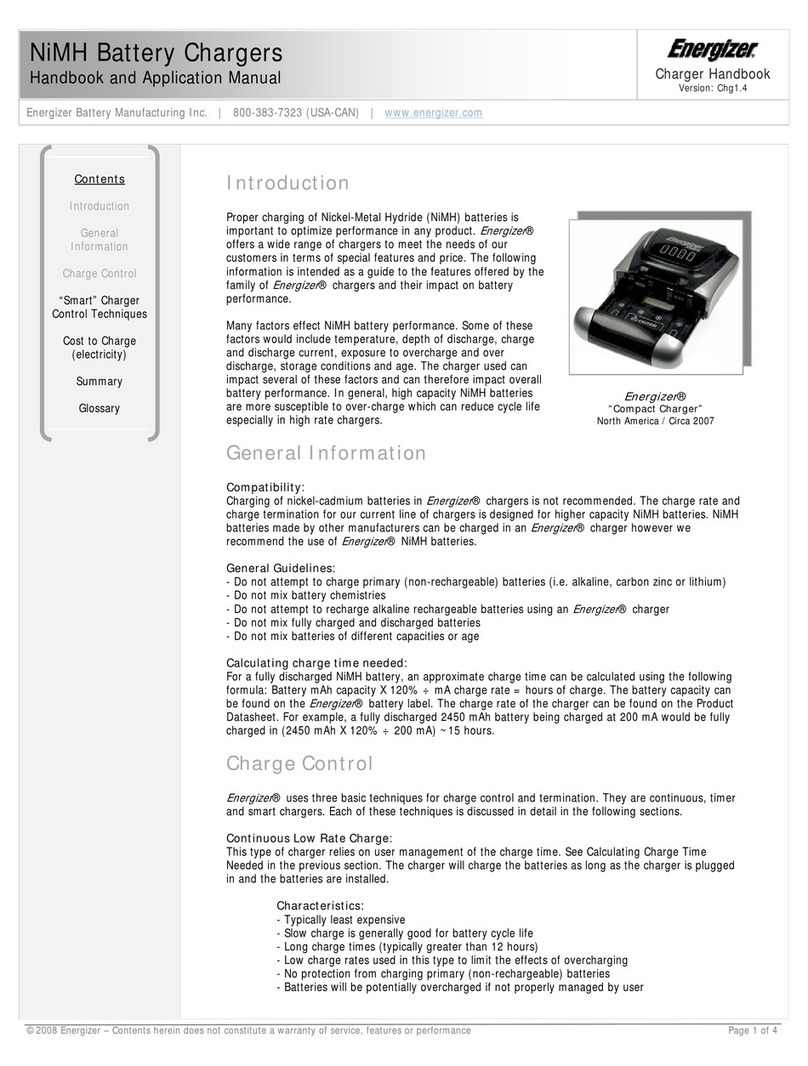
6
PREPARING TO CHARGE
a. If it’s necessary to remove the battery from the vehicle to charge it, always remove
the earth terminal from the battery first. Make sure all accessories in the vehicle are off, so
as not to cause a spark.
b. Ensure that the area around the battery is well ventilated while charging.
c. Clean battery terminals; being careful to keep corrosion from coming in contact with eyes.
d. Add distilled water to each cell until the battery’s acid reaches level specified by the
battery’s manufacturer. This helps purge excessive gas from cells. Do not overfill.
For a battery without cell caps, carefully follow manufacturer's recharging instructions.
e. Study all the battery manufacturer's specific precautions such as removing or not
removing cell caps while charging and recommended rates of charge.
f. Determine the voltage of the battery by referring to the car owner's manual and make sure
that the output voltage is set to the correct voltage. If the charger has an adjustable charge
rate, charge the battery at the lowest rate initially.
CHARGER LOCATION
a. Locate the charger as far away from the battery as the cables will allow.
b. Never place the charger directly above the battery being charged; gases from battery will
corrode and damage the charger.
c. Never allow battery acid to drip on to the charger when reading the specific gravity or
filling the battery.
d. Do not operate the charger in an enclosed area, or restrict ventilation in any way.
e. Do not put a battery on top of the charger.
DC CONNECTION PRECAUTIONS
a. Only connect/disconnect DC output clamps when the charger is switched off and
unplugged. Never allow clamps to touch each other.
b. Attach clamps to battery posts and twist or rock back and forth several times to ensure a
good connection. This tends to keep the clamps from slipping off the terminals and helps
to reduce risk of sparking.
FOLLOW THESE STEPS WHEN THE BATTERY IS INSTALLED IN THE VEHICLE.
A SPARK NEAR THE BATTERY MAY CAUSE THE BATTERY TO EXPLODE. TO
REDUCE THE RISK OF A SPARK NEAR THE BATTERY:
a. Ensure that the AC and DC cords are positioned to avoid damage by the bonnet, door, or
moving engine parts.
b. Stay clear of fan blades, belts, pulleys, and other parts that could cause injury.
c. Check polarity of battery posts. The POSITIVE (POS, P, +) battery post usually has a
larger diameter than the NEGATIVE (NEG, N, -) post.
d. Determine which post of the battery is grounded (connected) to the chassis. If the negative
post is grounded to chassis (as in most vehicles), go to section "e". If the positive post is
grounded to the chassis, go to section "f".
e. For negative-grounded vehicle, connect the POSITIVE (RED) clamp from the battery
charger to the POSITIVE (POS, P, +) ungrounded post of the battery. Connect the
NEGATIVE (BLACK) clamp to the vehicle’s chassis or engine block, away from the
battery. Do not connect the clamp to the carburettor, fuel lines, or sheet metal body parts.
Connect to a heavy gage metal part of the frame or engine block.
f. For positive-grounded vehicle, connect the NEGATIVE (BLACK) clamp from the battery
charger to the NEGATIVE (NEG, N, -) ungrounded post of the battery. Connect the
POSITIVE (RED) clamp to the vehicle’s chassis or engine block, away from the battery.
Do not connect the clamp to the carburettor, fuel lines, or sheet-metal body parts.
Connect to a heavy gage metal part of the frame or the engine block.
g. When disconnecting the charger, disconnect the AC cord, remove the clamp from the
vehicle’s chassis, and then remove the clamp from the battery terminal.
h. See the ‘Length of Charge’ section for additional guidance.
FOLLOW THESE STEPS WHEN THE BATTERY IS OUTSIDE THE VEHICLE. A SPARK
NEAR THE BATTERY MAY CAUSE THE BATTERY TO EXPLODE. TO REDUCE RISK
OF A SPARK NEAR THE BATTERY:
a. Only connect/disconnect DC output clamps when the charger is switched off and
unplugged. Never allow clamps to touch each other.
b. Connect the POSITIVE (RED) charger clamp to the POSITIVE (POS, P, +) post of
the battery.
c. Position yourself and free end of cable as far away from battery as possible - then
connect the NEGATIVE (BLACK) charger clamp to free end of cable.
d. Do not face the battery when making the final connection.
e. When disconnecting the charger, always do so in the reverse sequence of connecting it
and take off the first connection as far away from the battery as practical.
f. A marine (boat) battery must be removed and charged on shore, charging it on board
requires specially designed equipment, for marine use.
AC POWER CORD CONNECTION INSTRUCTIONS:
DANGER. Never alter the AC cord or plug provided - if it will not fit the outlet, seek
professional advice from a qualified electrician. Improper connection can result in a risk of
electric shock.
LENGTH OF CHARGE
The following instructions will allow you to determine how long it will take to bring your battery
to full charge.
a. Test the battery’s charge with a hydrometer or electronic tester.
b. Determine the size of the battery in Amp-Hour or Reserve Capacity. If the ratings are not
printed on the battery, contact your local battery dealer for this information. These are the
only ratings that can be used to determine charge time.
c. Use the battery’s rating and charge level, together with the amp setting to be used on the
charger in the formula below:
Amp Hour Rating of Battery × Percent of Charged Needed
Amp Setting Selected On Charger
× 1.3 = Hours to Charge
NOTE: Charge times are approximate and vary from battery to battery. Always follow the
battery manufacturer’s specific charging instructions.
